Erbium-Doped Optical Fiber Amplifiers
Scott Prahl
Sept 2023
[1]:
# Jupyterlite support for ofiber
try:
import micropip
await micropip.install("ofiber")
except ModuleNotFoundError:
pass
import matplotlib.pyplot as plt
import numpy as np
import scipy
import scipy.integrate
import ofiber
# to make graphs a bit better
%config InlineBackend.figure_format='retina'
[2]:
q = scipy.constants.eV # Joules
c = scipy.constants.speed_of_light # m/s
k = scipy.constants.Boltzmann # J/Kelvin
h = scipy.constants.Planck
cross_lambda = 1e-9*np.array([1500.3, 1505.5, 1509.7, 1514.9, 1520.2, 1525.4, 1530.6, 1535.9, 1540.1, 1545.3, 1550.5, 1555.8, 1560.0, 1565.2, 1570.4, 1575.7, 1579.8, 1585.1, 1590.3, 1595.6, 1600.8, 1605.0, 1610.2, 1615.5, 1619.6, 1624.9, 1630.1, 1635.3, 1640.6])
cross_sigma_a = 1e-25*np.array([ 2.257, 2.403, 2.553, 2.744, 3.365, 4.421, 5.379, 4.644, 3.154, 2.850, 2.545, 2.229, 1.859, 1.303, 0.934, 0.759, 0.654, 0.576, 0.503, 0.459, 0.442, 0.402, 0.378, 0.345, 0.325, 0.292, 0.276, 0.252, 0.252])
cross_sigma_se = 1e-25*np.array([ 1.133, 1.340, 1.514, 1.884, 2.489, 3.495, 4.709, 4.644, 3.503, 3.386, 3.410, 3.057, 2.801, 2.180, 1.717, 1.303, 1.133, 0.978, 0.889, 0.804, 0.727, 0.670, 0.609, 0.544, 0.487, 0.426, 0.369, 0.309, 0.268])
def absorption_cross_section(λ):
'''
Return the absorption cross section (m**2) for a typical erbium doped fiber
at a wavelength λ (m) based on ghatak Table 14.1
'''
return np.interp(λ, cross_lambda, cross_sigma_a)
def emission_cross_section(λ):
'''
Return the emission cross section (m**2) for a typical erbium doped fiber
at a wavelength λ (m) based on ghatak Table 14.1
'''
return np.interp(λ, cross_lambda, cross_sigma_se)
Figure 14.13
[3]:
ell = 0
em = 1
core_radius = 1.5e-6
NA = 0.24
r = np.linspace(0,8* core_radius,2000)
area = np.pi * core_radius**2
plt.subplots(2,1,figsize=(6,12))
λ = 980e-9
V = ofiber.V_parameter( core_radius,NA,λ)
b = ofiber.LP_mode_value(V, ell, em)
E_true = ofiber.LP_radial_irradiance(V, b, ell, r/ core_radius)/area
E_env = ofiber.gaussian_radial_irradiance(V, r/ core_radius)/area
plt.subplot(2,1,1)
plt.plot(r*1e6, E_true*1e-12)
plt.plot(r*1e6, E_env*1e-12)
plt.axvline( core_radius*1e6, color='black')
plt.xlabel("Radial Position (microns)")
plt.ylabel("Normalized Irradiance")
plt.title('Ghatak Figure 14.13a ($\lambda$=%.0f nm)'% (λ*1e9))
λ = 1500e-9
V = ofiber.V_parameter( core_radius,NA,λ)
b = ofiber.LP_mode_value(V, ell, em)
E_true = ofiber.LP_radial_irradiance(V, b, ell, r/ core_radius)/area
E_env = ofiber.gaussian_radial_irradiance(V, r/ core_radius)/area
plt.subplot(2,1,2)
plt.plot(r*1e6, E_true*1e-12)
plt.plot(r*1e6, E_env*1e-12)
plt.axvline( core_radius*1e6, color='black')
plt.xlabel("Radial Position (microns)")
plt.ylabel("Normalized Irradiance")
plt.title('Ghatak Figure 14.13b ($\lambda$=%.0f nm)'% (λ*1e9))
plt.show()
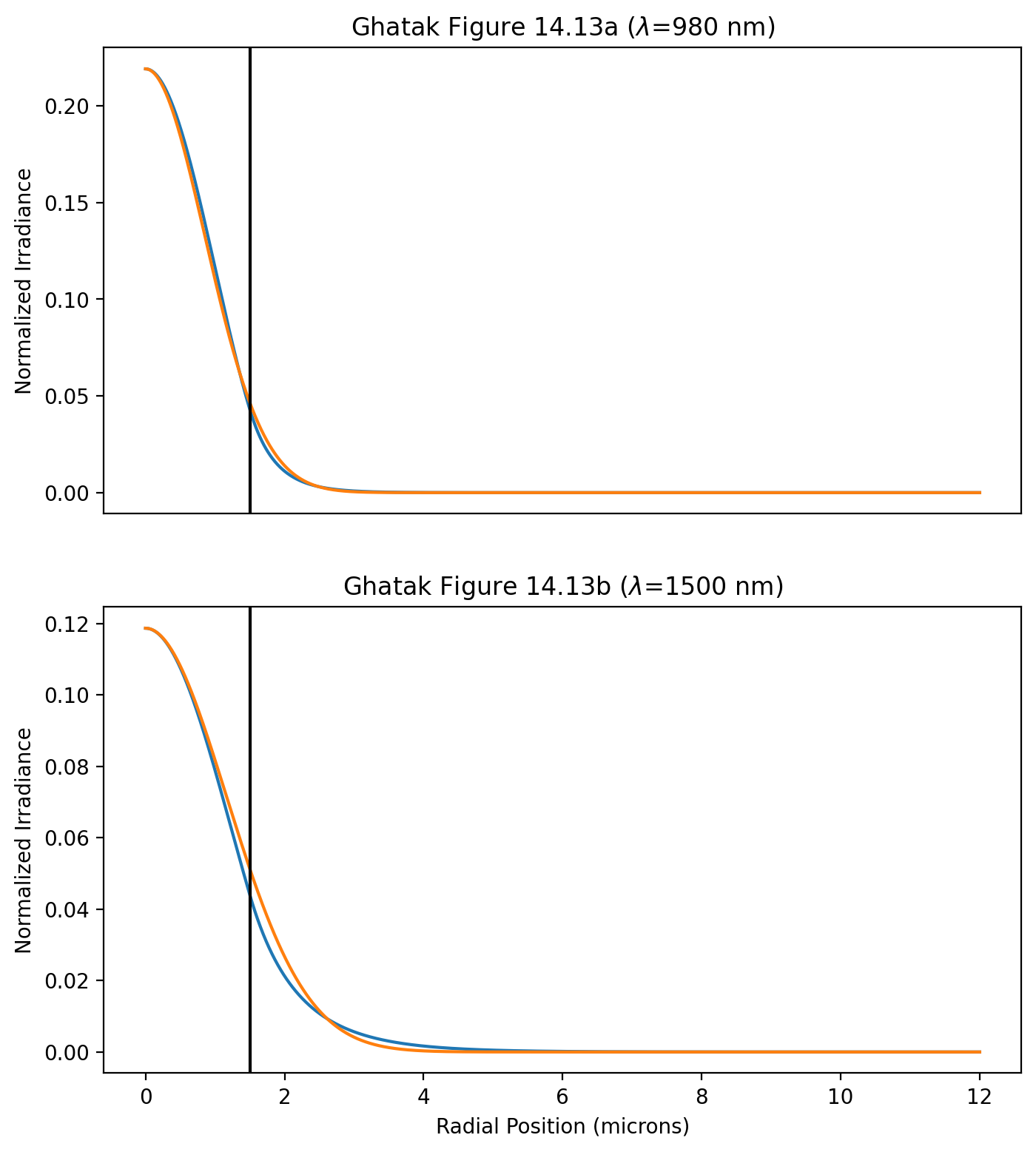
Normalization
The total power is normalized to the area of the core
thus if \(f(r)\)=gaussian_radial_irradiance(V,r/a)/(np.pi*a**2) then
[4]:
print(2*np.trapz(E_env*area*r/ core_radius, r/ core_radius) )
print(2*np.pi*np.trapz(E_env*r, r) )
print(2*np.trapz(E_true*area*r/ core_radius, r/ core_radius) )
print(2*np.pi*np.trapz(E_true*r, r) )
0.9999977611012747
0.9999977611012746
0.9999780668306247
0.9999780668306248
Figures 14.14
This is simple because it is a single non-linear ODE
[5]:
def dPp_dz(Pp, z, Pp0, N_0, abs_pump, b_over_omega):
'''equation 14.56 in Ghatak'''
return abs_pump * Pp0 * N_0 * np.log((1+(Pp/Pp0)*np.exp(-b_over_omega**2))/(1+Pp/Pp0))
lambda_pump = 980e-9 # m
N_0 = 6.8e24 # Er ions per m**3
core_radius = 1.64e-6 # m fiber core
doped_radius = core_radius # m Er doping radius
NA = 0.21
Ip0 = 7.81e7 # W/m**2
abs_pump = absorption_cross_section(lambda_pump)
V_pump = ofiber.V_parameter( core_radius, NA, lambda_pump)
Omega_pump = ofiber.gaussian_envelope_Omega(V_pump) * core_radius
b_over_omega = doped_radius / Omega_pump
Pp0 = Ip0 * np.pi * Omega_pump**2
z = np.linspace(0,7,20) # meters along doped fiber
Pin = 7 # mW
sol = scipy.integrate.odeint(dPp_dz, Pin*1e-3, z, args=(Pp0, N_0, abs_pump, b_over_omega))
Pp = sol[:,0]
plt.plot(z,Pp*1e3)
plt.text(0,Pin,"P$_{in}$=%.0f mW" % Pin)
Pin = 5 # mW
sol = scipy.integrate.odeint(dPp_dz, Pin*1e-3, z, args=(Pp0, N_0, abs_pump, b_over_omega))
Pp = sol[:,0]
plt.plot(z,Pp*1e3)
plt.text(0,Pin,"P$_{in}$=%.0f mW" % Pin)
Pin = 3 # mW
sol = scipy.integrate.odeint(dPp_dz, Pin*1e-3, z, args=(Pp0, N_0, abs_pump, b_over_omega))
Pp = sol[:,0]
plt.plot(z,Pp*1e3)
plt.text(0,Pin,"P$_{in}$=%.0f mW" % Pin)
plt.xlabel("Position Along Er-doped Fiber (m)")
plt.ylabel("Pump Power (mW)")
plt.title("Ghatak Figure 14.14")
plt.show()
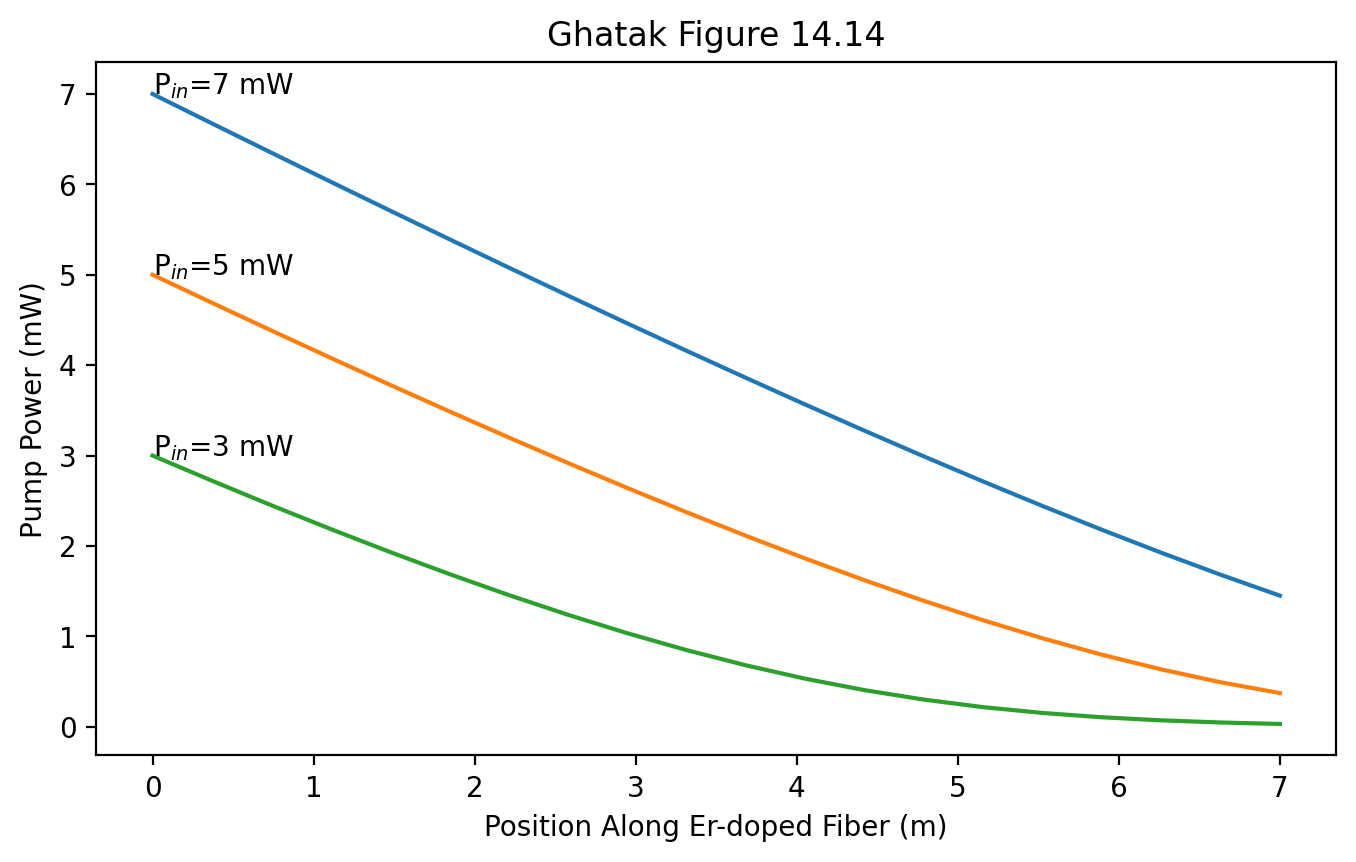
Figures 14.15
This is a bit trickier because there are are two coupled ODEs.
[6]:
def erbium(y, z, Pp0, A_p, b_over_omega_p, A_s, b_over_omega_s, eta_s):
'''equation 14.56 and 14.57 in Ghatak'''
P_p, P_s = y
p = P_p/Pp0
dPp_dz = A_p * np.log((1+p*np.exp(-b_over_omega**2))/(1+p))
dPs_dz = alpha = eta_s * p *(1-np.exp(-b_over_omega_s**2))
dPs_dz += (1+eta_s)*np.log((1+p*np.exp(-b_over_omega_s**2))/(1+p))
dPs_dz *= A_s * P_s / P_p
return [dPp_dz, dPs_dz]
lambda_pump = 980e-9 # m
lambda_signal = 1550e-9 # m
N_0 = 6.8e24 # Er ions per m**3
core_radius = 1.64e-6 # m fiber core
doped_radius = core_radius # m Er doping radius
NA = 0.21
Ip0 = 7.81e7 # W/m**2
Ps0 = 1e-6 # W
eta_s = 1
abs_pump = 2.17e-25 # m**2
abs_signal = absorption_cross_section(lambda_signal)
ems_signal = emission_cross_section(lambda_signal)
eta_s = ems_signal/abs_signal
V_pump = ofiber.V_parameter( core_radius, NA, lambda_pump)
Omega_pump = ofiber.gaussian_envelope_Omega(V_pump) * core_radius
V_signal = ofiber.V_parameter( core_radius, NA, lambda_signal)
Omega_signal = ofiber.gaussian_envelope_Omega(V_signal) * core_radius
b_over_omega_p = doped_radius / Omega_pump
b_over_omega_s = doped_radius / Omega_signal
Pp0 = Ip0 * np.pi * Omega_pump**2
A_p = N_0 * abs_pump * Pp0
A_s = N_0 * abs_signal * Pp0
z = np.linspace(0,7,20) # meters along doped fiber
Pin = 7 # mW
sol = scipy.integrate.odeint(erbium, [Pin*1e-3,Ps0], z, args=(Pp0, A_p, b_over_omega_p, A_s, b_over_omega_s, eta_s))
Pp = sol[:,0]
Ps = sol[:,1]*1e6
plt.plot(z,Ps)
plt.text(z[-1],Ps[-1],"P$_{in}$=%.0f mW" % Pin, ha='right')
Pin = 5 # mW
sol = scipy.integrate.odeint(erbium, [Pin*1e-3,Ps0], z, args=(Pp0, A_p, b_over_omega_p, A_s, b_over_omega_s, eta_s))
Pp = sol[:,0]
Ps = sol[:,1]*1e6
plt.plot(z,Ps)
plt.text(z[-1],Ps[-1],"P$_{in}$=%.0f mW" % Pin, ha='right')
Pin = 3 # mW
sol = scipy.integrate.odeint(erbium, [Pin*1e-3,Ps0], z, args=(Pp0, A_p, b_over_omega_p, A_s, b_over_omega_s, eta_s))
Pp = sol[:,0]
Ps = sol[:,1]*1e6
plt.plot(z,Ps)
plt.text(z[-1],Ps[-1],"P$_{in}$=%.0f mW" % Pin, ha='right')
plt.xlabel("Position Along Er-doped Fiber (m)")
plt.ylabel("Signal Power ($\mu$W)")
plt.title("Ghatak Figure 14.15")
plt.grid(True)
plt.show()
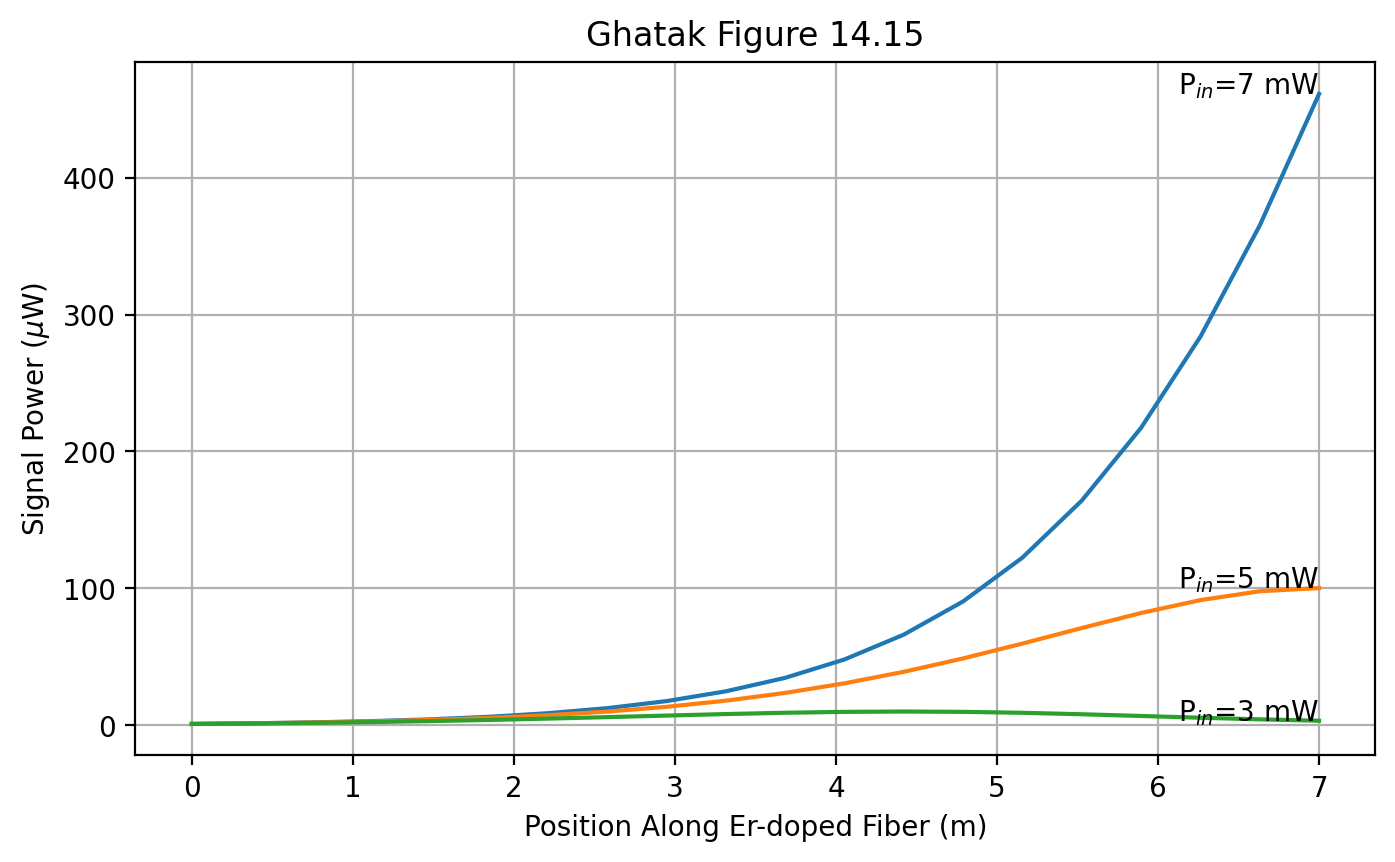
Figures 14.16
Exactly the same as above, but take the log of the results
[7]:
Pin = 7 # mW
sol = scipy.integrate.odeint(erbium, [Pin*1e-3,Ps0], z, args=(Pp0, A_p, b_over_omega_p, A_s, b_over_omega_s, eta_s))
Pp = sol[:,0]
Ps = 10*np.log10(sol[:,1]/Ps0)
plt.plot(z,Ps)
plt.text(z[-1],Ps[-1],"P$_{in}$=%.0f mW" % Pin, ha='right')
Pin = 5 # mW
sol = scipy.integrate.odeint(erbium, [Pin*1e-3,Ps0], z, args=(Pp0, A_p, b_over_omega_p, A_s, b_over_omega_s, eta_s))
Pp = sol[:,0]
Ps = 10*np.log10(sol[:,1]/Ps0)
plt.plot(z,Ps)
plt.text(z[-1],Ps[-1],"P$_{in}$=%.0f mW" % Pin, ha='right')
Pin = 3 # mW
sol = scipy.integrate.odeint(erbium, [Pin*1e-3,Ps0], z, args=(Pp0, A_p, b_over_omega_p, A_s, b_over_omega_s, eta_s))
Pp = sol[:,0]
Ps = 10*np.log10(sol[:,1]/Ps0)
plt.plot(z,Ps)
plt.text(z[-1],Ps[-1],"P$_{in}$=%.0f mW" % Pin, ha='right')
plt.xlabel("Position Along Er-doped Fiber (m)")
plt.ylabel("Signal Gain (dB)")
plt.title("Ghatak Figure 14.16")
plt.grid(True)
plt.show()
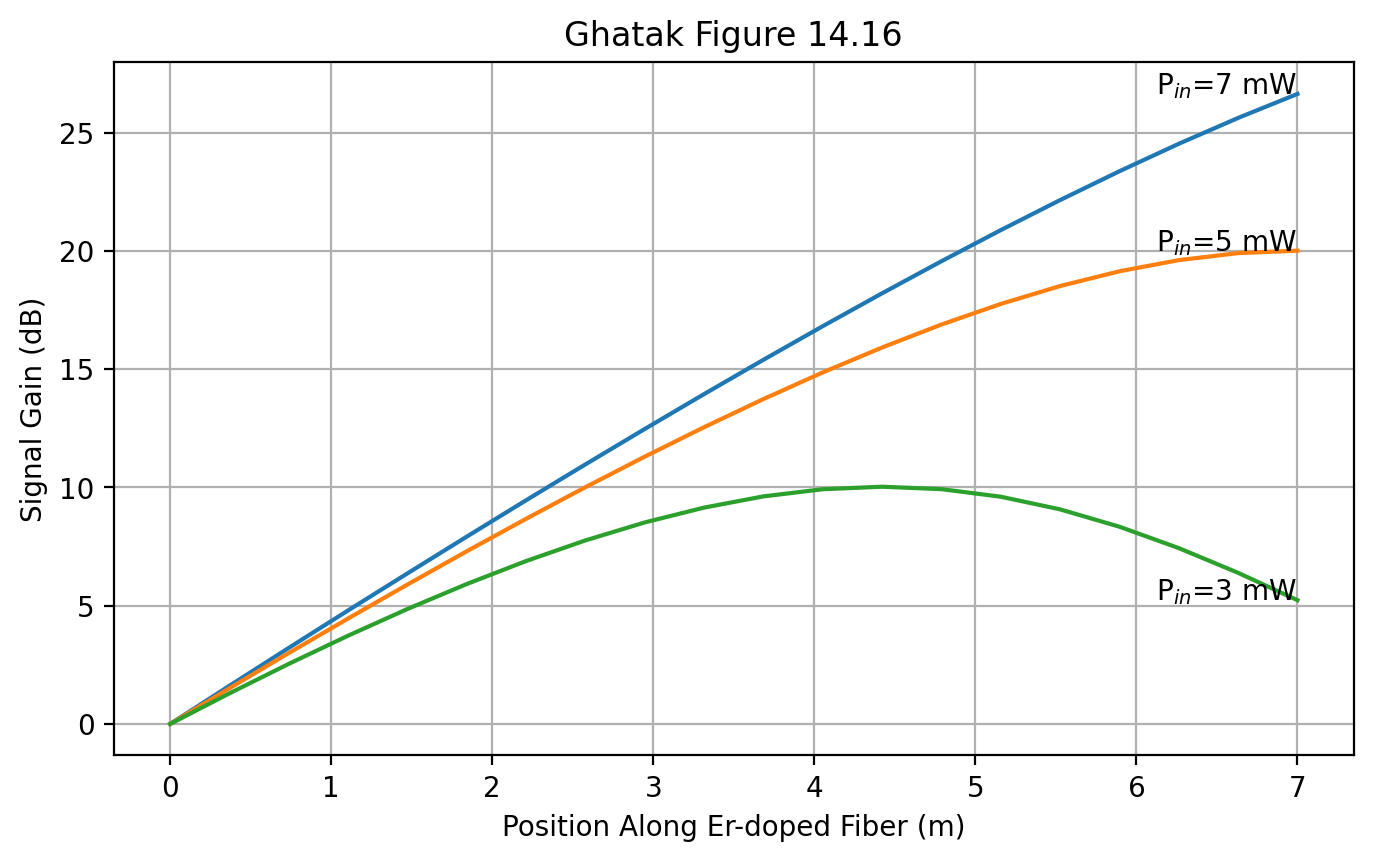
Problem 14.2
For the fiber parameters given by equation (14.58), assuming low signal power, obtain the threshold pump power required for amplification of the signal at any value of \(z\).
[8]:
pump_wavelength = 980e-9 # m
signal_wavelength = 1550e-9 # m
#typical erbium doped fiber
core_radius = 1.64e-6 #m r
doped_radius = 1.64e-6 #m doping_radius
NA = 0.21
abs_pump = absorption_cross_section(pump_wavelength)
abs_signal = absorption_cross_section(signal_wavelength)
ems_signal = emission_cross_section(signal_wavelength)
print(abs_pump)
print(abs_signal)
print(ems_signal)
t_sp = 12e-3 #s
doping_con = 6.8e24 #m^-3 doping_concentration
pump_abs = 2.17e-25 #m^2 pump_absorption_cross_section
signal_abs = 2.57e-25 #m^2 signal_absorption_cross_section
signal_em = 3.41e-25 #m^2 signal_emission_cross_section
V_p = ofiber.V_parameter( core_radius, NA, pump_wavelength)
Omega_p = ofiber.gaussian_envelope_Omega(V_p) * core_radius
print(Omega_p)
V_s = ofiber.V_parameter( core_radius, NA, signal_wavelength)
Omega_s = ofiber.gaussian_envelope_Omega(V_s) * core_radius
print(Omega_s)
# solving for the gaussian envelope approximation
ko_pump = 2*np.pi/pump_wavelength
ko_signal = 2*np.pi/signal_wavelength
Vp = ko_pump*core_radius*NA
Vs = ko_signal*core_radius*NA
Wp = 1.1428*Vp-0.996 #using the approximation from chapter 8.
Ws = 1.1428*Vs-0.996 #using the approximation from chapter 8. (stretching the appoximation criteria out)
Up = np.sqrt(Vp**2-Wp**2)
Us = np.sqrt(Vs**2-Ws**2)
gaussian_pump = core_radius*scipy.special.j0(Up)*(Vp/Up)*(scipy.special.k1(Wp)/scipy.special.k0(Wp))
gaussian_signal = core_radius*scipy.special.j0(Us)*(Vs/Us)*(scipy.special.k1(Ws)/scipy.special.k0(Ws))
n_s = signal_em/signal_abs
print('''Gaussian pump envelope = {0:.2f}um
Gaussian signal envelope = {1:.2f}um
ns = {2:.2f}'''.format(gaussian_pump*1e6,gaussian_signal*1e6,n_s))
I_p0 = (h*(c/pump_wavelength))/(pump_abs*t_sp)
P_p0 = np.pi*gaussian_pump**2*I_p0
#print('''Threshold pump Irradiance = {0:.2e} W/m^2
#Threshold pump power = {1:.1e} mW'''.format(I_p0,P_p0*1e3))
#####################################################################################
# To have amplification at any z vaue dPs/dz must be > 0.
#expression whose roots to find
def threshold_Pp (Pp):
a = (Pp/P_p0)* n_s * (1-np.exp((-core_radius**2/gaussian_signal**2)))
b = (1+n_s) * np.log((1 + (Pp/P_p0)*np.exp(-core_radius**2/gaussian_signal**2))/(1 + (Pp/P_p0)))
return a+b
#plotting
Pp = np.linspace(-.25,.25,100)
plt.plot(Pp,threshold_Pp(Pp))
plt.xlabel("Pump Power [W]")
plt.ylabel("$\\frac{dP_s}{d_z}$")
plt.hlines(0,-.25,.25,colors='k',linestyle='--')
plt.annotate('Threshold',xy=(-.2,-50))
plt.grid()
threshold_initial_guess= 0.05
threshold_solution = scipy.optimize.fsolve(threshold_Pp, threshold_initial_guess)
print ("The solution is threshold power = {0}mW".format(threshold_solution[0] * 1e3))
print ("at which the value of the expression is %f" % threshold_Pp(threshold_solution)[0])
print ('Thus Pp/Pp0 = {:.2f}'.format(P_p0/threshold_solution[0]))
#couldn't get code to produce correct answer from graphs so used easier method below
#####################################################################################
#I_p0 = (h*(c/pump_wavelength))/(pump_abs*t_sp)
#P_p0 = pi*gaussian_pump**2*I_p0
#print('''Threshold pump Irradiance = {0:.2e} W/m^2
#Threshold pump power = {1:.1e} mW'''.format(I_p0,P_p0*1e3))
2.257e-25
2.5743269230769257e-25
3.407692307692308e-25
1.3484911622805945e-06
1.9500339473533436e-06
Gaussian pump envelope = 1.35um
Gaussian signal envelope = 1.95um
ns = 1.33
The solution is threshold power = 0.45489300717913156mW
at which the value of the expression is -0.000000
Thus Pp/Pp0 = 0.97
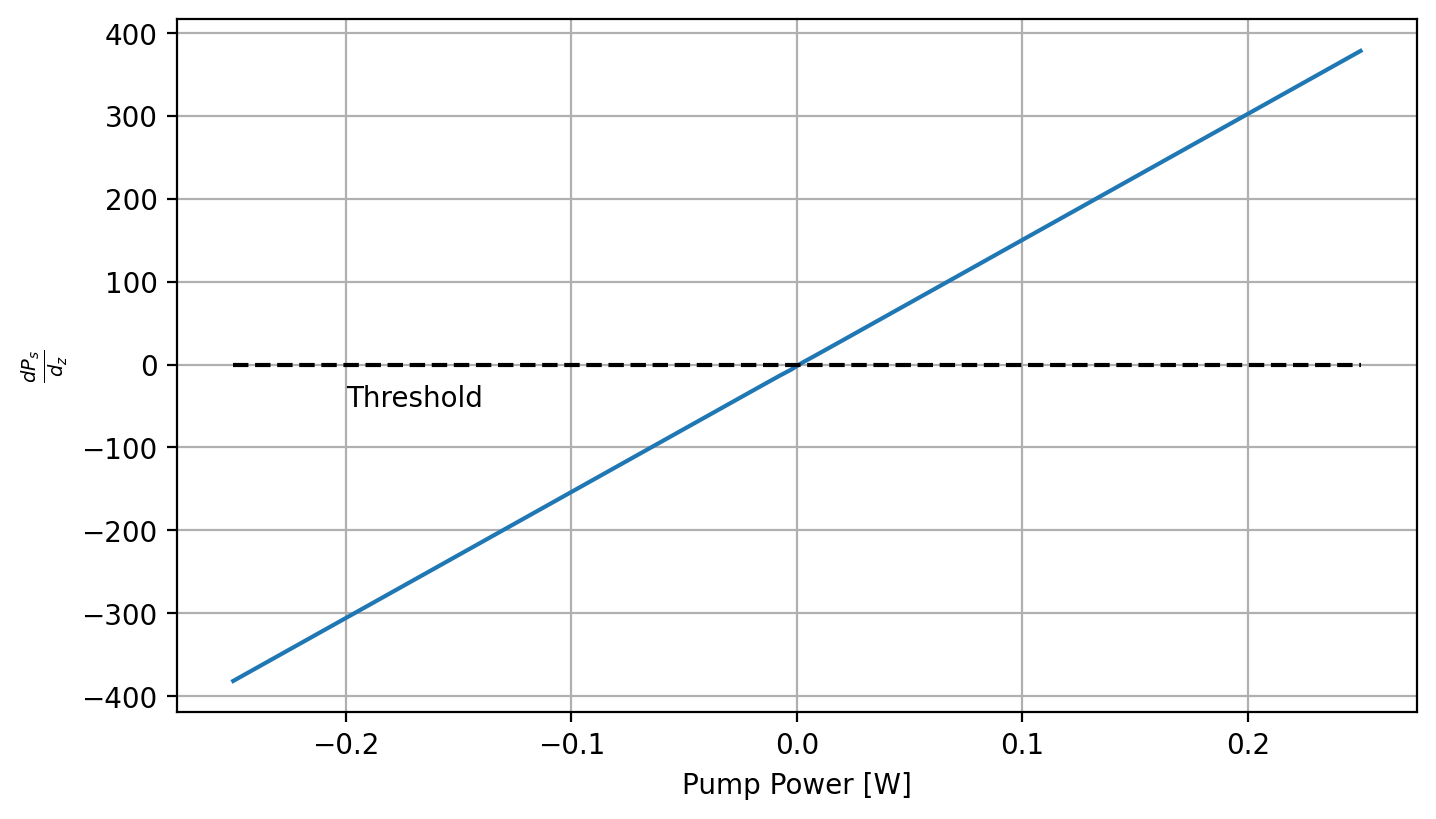
Problem 14.3
For a fiber above, calculate the threshold pump powers corresponding to a signal wavelength of 1530 nm assuming 𝜎_sa = 5.25 x 10^{-25} m², 𝜎_se = 4.36 x 10-25 m²)
[9]:
signal_wavelength = 1530e-9
signal_em = 4.36e-25
signal_abs = 5.25e-25
ko_pump = 2*np.pi/pump_wavelength
ko_signal = 2*np.pi/signal_wavelength
Vs = ko_signal*core_radius*NA
Ws = 1.1428*Vs-0.996 #using the approximation from chapter 8. (stretching the appoximation criteria out)
Us = np.sqrt(Vs**2-Ws**2)
gaussian_signal = core_radius*scipy.special.j0(Us)*(Vs/Us)*(scipy.special.k1(Ws)/scipy.special.k0(Ws))
n_s = signal_em/signal_abs
print('''Gaussian pump envelope = {0:.2f}um
Gaussian signal envelope = {1:.2f}um
ns = {2:.2f}'''.format(gaussian_pump*1e6,gaussian_signal*1e6,n_s))
I_p0 = (h*(c/pump_wavelength))/(pump_abs*t_sp)
P_p0 = np.pi*gaussian_pump**2*I_p0
#print('''Threshold pump Irradiance = {0:.2e} W/m^2
#Threshold pump power = {1:.1e} mW'''.format(I_p0,P_p0*1e3))
#####################################################################################
# To have amplification at any z vaue dPs/dz must be > 0.
#expression whose roots to find
def threshold_Pp (Pp):
a = (Pp/P_p0)* n_s * (1-np.exp((-core_radius**2/gaussian_signal**2)))
b = (1+n_s) * np.log((1 + (Pp/P_p0)*np.exp(-core_radius**2/gaussian_signal**2))/(1 + (Pp/P_p0)))
return a+b
threshold_initial_guess= 0.1
threshold_solution = scipy.optimize.fsolve(threshold_Pp, threshold_initial_guess)
print ("The solution is threshold power = {0}mW".format(threshold_solution[0] * 1e3))
print ("at which the value of the expression is %f" % threshold_Pp(threshold_solution[0]))
Gaussian pump envelope = 1.35um
Gaussian signal envelope = 1.92um
ns = 0.83
The solution is threshold power = 0.7364547431342711mW
at which the value of the expression is -0.000000
Problem 14.4
Consider an erbium-doped fiber with Ω_p = 1.591 𝜇m, Ω_s = 2.2881 𝜇m, and a core radius of 2.5 𝜇m. Estimate the threshold pump power required for achieving amplification at any value of z for doping radii b = a, 0.5a, 0.25a, and 0.1a for a signal wavelength of 1550 nm for which 𝜂_s = 1.327. Assume 𝜎_pa = 2.17e-25 m², t_sp = 12 ms, λ_p = 980 𝜇m.
[10]:
gaussian_pump = 1.591e-6 #m
gaussian_signal = 2.288e-6 #m
a = 2.5e-6 #m Core Radius
dopping_radius = [a,a*.5,a*.25,a*.1]
r = 2.5e-6*.1
signal_wavelength = 1550e-9 #m
ns = 1.327
pump_abs = 2.17e-25# m^2
tsp = 12e-3 #s
pump_wavelength = 980e-9 #m
I_p0 = (h*(c/pump_wavelength))/(pump_abs*tsp)
Pp0 = np.pi*gaussian_pump**2*I_p0
def threshold_Pp (Pp):
a = (Pp/Pp0)* ns * (1-np.exp((-r**2/gaussian_signal**2)))
b = (1+n_s) * np.log((1 + (Pp/Pp0)*np.exp(-r**2/gaussian_signal**2))/(1 + (Pp/Pp0)))
return a+b
#for d in dopping_radius:
threshold_initial_guess= .6
threshold_sol = scipy.optimize.fsolve(threshold_Pp, threshold_initial_guess)
print ("The solution is threshold power = {0}mW".format(threshold_sol[0] * 1e3))
print ("at which the value of the expression is %f" % threshold_Pp(threshold_sol)[0])
The solution is threshold power = 0.23626213562299364mW
at which the value of the expression is 0.000000
[ ]: